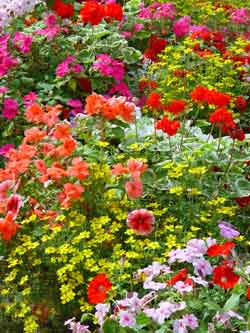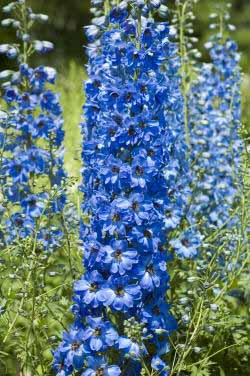Annual vs. Perennial Plants and Flowers in the garden
Before comparing the advantages and disadvantages of either perennial plants or annuals – a basic gardening definition of perennial plant
A perennial is a garden flowering garden plant that lives for more than one year – often 4 or 5 years; sometimes longer. Perennial flowers are normally herbaceous, but can also be evergreen.
An annual garden plant is one which is grown from seed, flowers and then dies; all in the same year. Annual flowers are normally sown in the spring to grow; bloom; and set seed in the summer and autumn and then die immediately after seeding.
We will ignore the plants that are classed as biennials for this page. Biennials are almost the same as annuals. The main difference being that they are sown the year before they flower. Most are sown in late summer to grow through the autumn and then flower the following year – normally in spring or early summer.
Bearing in mind that perennials will last for several years whilst the annuals are for one year, it would seem an obvious choice to plant nothing but perennial plants. Many gardeners choose this option and often frown upon the use of annuals. There are advantages and disadvantages to both types – perennials and annuals.
 Pros
and Cons of Perennial and Annual flowers
Pros
and Cons of Perennial and Annual flowers
The advantages or otherwise of each group depends a lot on your own aspect of gardening and lifestyle to a certain extent. Your choice may be influenced by cost, convenience, or simply because that is what you do!
Length of Flowering time for perennials and Annuals
There is little doubt that annuals give a far greater mass of flowers – for a longer period – than do perennials. Many annual bedding plants will flower for most of the summer and well into the autumn before dying. Perennials on the other hand have a shorter flowering period – sometimes only a few weeks. 3 to 5 weeks of good flowering for a perennial plant is the norm.
Some perennials can have two flushes of flowers, if the first faded flowers are cut off. This allows for new growth with will sometimes flower again later in the year.
Cost Difference between Annuals and Perennial plants
Annuals are normally bought in strips of 8 -10 small plants late spring or early summer, then each small flower planted in beds, borders or containers, ranging from patio post to hanging baskets. The cost per strip of annual bedding plants is generally double the price of a single perennial plant which is normally sold singly – in a small pot. Some perennials are sold as 1 year old plants in a 6in (15cm) container with a premium cost for the larger plant.
Perennials will normally give several years of service – as a plant – whereas the annual bedding plant is yours for one year – to be renewed the following year. Perennials also have the advantage that they can normally be divided after the first two years, so extra plants later on, are free!
Flower Power – Perennials vs Annuals
The deciding factor for most gardeners – is the actual flower power of the two groups – very different with advantages in both camps. Of course, it does not have to be either one or the other, some of the best garden shows are as a result of mixed plantings of perennials and annuals – and shrubs etc.
When it comes down to the choice of concerning flowering period, the annuals – with their long flowering period – are out and out winners. Most popular annual bedding plants will have flowers from late May through until September or even October. That’s around 16 – 20 weeks of flower per plant.
Perennials on the other hand have shorter flowering period (generally) of around 3-5 weeks – average of 4 weeks per plant. In statistical terms, that means that the annuals outdo perennials with a ratio of around 5:1, meaning that most perennials would need 4 to 5 years to provide you with as much flower! Build into that, the fact that you would have to buy bedding plants for each of the 4 or 5 years, whilst the perennial would be happy to repay your initial investment with years of ‘return’!
The difference in perennials and annuals can be forcibly argued in shape and form.
 Annuals
are generally referred to as bedding plants, as the plants are generally
low compact growers which, when planted en masse provide a bed or carpet
of colour with gently undulating contours owing to the height element.
Annuals generally grow into plants between 6in - 18in tall (15-45cm).
Annuals
are generally referred to as bedding plants, as the plants are generally
low compact growers which, when planted en masse provide a bed or carpet
of colour with gently undulating contours owing to the height element.
Annuals generally grow into plants between 6in - 18in tall (15-45cm).
There are a few annuals that exceed this height, but the fact that they grow for one year only usually restricts the height they attain in that short timescale. Because of this, they are limited to planting at the front of borders – shrub and perennial.
Perennials on the other hand have several years in which to put on height – rarely reaching their ultimate height in the first year. This allows them the be planted in a wider range of situations in the garden – including the front, middle or back of borders and beds – giving a rather informal aspect to the planting scheme.
Container Growing Annual against Perennial Plants
Containers such as patio pots, window boxes and hanging baskets are generally home to annuals rather than perennials. Such plantings normally call for ‘instant’ results – provided by annuals – and masses of colour for the summer months. Perennials do not generally fit into this pattern of gardening.
There are several perennials which have good or even spectacular foliage, which can be the basis of a good patio pot display, though this is rarely the case in window boxes or hanging baskets.
Growing and Care differences between Perennials and Annuals
Annuals have to be planted every year, whilst perennials are happy to occupy a given position for several years. That is an over simplification that seems to suggest that perennials win on a low maintenance basis. Not so, for perennials may need staking through the growing season, will need dividing every 2 or 3 years.
Perennials are prone to a wider range of pest and disease problems than annuals and as they are long term plants will generally require more care. But, once established, will rarely require watering other than in the driest of summers.
Annuals will require a little more added care and attention in the weeks after planting, together with which, if they are container grown, will need almost daily watering in hot summers.
An important thing to bear in mind, is that late frosts are not as harmful to perennials as they are to the hastily planted annual bedding plants.
Propagating Annuals or Perennials
Both types can be grown from seed, with the main difference being that annuals will normally need heat and protection for good germination. Most perennials can be sown in a cold frame in late summer, and most do not need any heat.
Perennials can also be raised from cuttings quite easily, whereas this is not so for true annuals. Division of perennial plants is usually necessary after two or three years for good health. It also provides additional plants – albeit the same colour as the parent plant!
Our Conclusion
Both types of plants have a place in most gardens. Perennials give the added advantage of maturity, with the heights that can be attained by some. As for the shorter flowering period of perennials, this is more than just compensated with the spectacular show of flowers such as Delphiniums, Lupins, Penstemons and Agapanthus to name a few.
Perennials – as with shrubs – can form a good basic background, which can be enhanced by the addition of annual bedding plants.
Best Selling Gardening Products
Popular Gardening Sections

Problems
Identify Weeds in The Garden - How to deal with weeds. Diseases and Pest which harm your garden and plants, learn how to prevent, deter and erradicate your garden problems.
Garden Problems
Pruning
Pruning Guide. Shrubs flower better with correct pruning. Many illustrations and examples of what to do - and when. Includes evergreens, roses, flowering shrubs, spring flowering shrubs and pruning for stem effect. This is our most viewed and comprehensive section,
Pruning
Gardening Businesses
Gardening Businesses listed in the UK counties and USA states. County and State Listings of businesses involved in Garden supplies and services. If you wish to be added to the Directory, please send us your information. Having problems, use the search box
Businesses
Gardening
In this section you will learn about Gardening Basics, Containers, Landscaping, Propagation and Soil.
Gardening
Gardening Gifts
Gardening Gifts and Reviews, Read Before you Buy
- Gardening Gifts Ideas
- Gifts For Her
- Gifts For Men
- Power Tool Gifts
- Cheap Gifts
- Personalised Gifts
- Wildlife Gifts
- Family Gifts



